Believe me: you hardly go a day without seeing or experiencing something created by a graphic designer. This is because the work of this professional is exposed in the most diverse media, such as websites, magazines, newspapers, social media, games and so on. Interesting, don’t you think?
Basically, what the graphic designer does is to develop visual communication processes. Through images, animations and texts, he uses his drawing skills, aesthetics, layout and, mainly, creativity to make communication happen. Are you getting more and more interested with each paragraph?
If you intend to continue in this profession, you need to know now the main activities of a graphic designer, how is your work routine and where you can work. Only then can you make a truly correct decision. The good news is that we have gathered here everything you need to know about the profession. So, check it out!

What does the graphic designer do, anyway?
As mentioned, a graphic designer is responsible for the visual creation of technical and creative processes to emit ideas, concepts and messages. The profession emerged as a branch of industrial design, involving the areas of graphic and product design.
The work of this professional also involves creating means for the propagation of messages, the organization of information and even the entertainment of the public.
The creations of a graphic designer are inserted in our daily life in the most different areas, such as:
- book covers and illustrations;
- product packaging;
- company logos and visual identity;
- cinema and TV vignettes;
- the layout of newspapers, books and magazines;
- creation of websites, social networks and blogs;
- games;
- ads.
How is this professional’s daily work?
For each job or project, the designer studies gaps identify possibilities and develop concepts related to what was requested. When well-chosen, typography, colors, graphic production, ergonomics and many other factors are capable of bringing positive results in an organized and aesthetically attractive way.
It is quite common for these professionals to participate in meetings with others involved in the creation process or in customer service itself since brainstorming (meeting to discuss ideas) is essential for the development of great products.
How is the job market?
With technology increasingly evolved and a new type of media being born practically every day, the number of new professionals in the area wishing to make a difference also increases. Because it is this constant demand that makes opportunities always high.
Naturally, therefore, the graphic design job market is highly competitive. Such competition means that professionals have to learn to publicize their work where it really matters, in addition, to constantly seeking to differentiate themselves from others, investing in specializations and seeking to innovate, always keeping an eye on the news. All of this is essential to increase the chances of hiring.
How to publicize the work?
It is vital to understand as soon as possible that the portfolio is the curriculum of graphic designers. It is in the portfolio, after all, that these professionals bring together their main projects and works, always taking care to update it with every new feature. Remember: customers or future companies will build on what you’ve already created and recognize your ability there.
At the end of the day, a portfolio is nothing more than a list that includes the best work of a professional. In the case of the graphic designer, this list is basically visual. There the drawings, illustrations, manipulations and any other creative solutions created by him during his journey are exposed.
What is the average salary for the profession?
In general, the average salary for graphic designers is usually between R $ 1,000 and R $ 5,000. The numbers go up as the professional advances in his career, acquiring more knowledge and, of course, experience.
Another factor that directly influences the salary of a professional in the category is the region where he lives and also several aspects related to his employer. In addition, if the designer decides to act as a freelancer, he will receive values according to the projects he carries out.
Where does a graphic designer work?
As you may have noticed, practically every sector today needs some kind of work done by graphic designers. Whether creating a logo or developing an international advertising campaign, the skills of this profession have never been more in demand.

Here are some examples of companies in which a designer can work:
- advertising agencies of the most varied sizes;
- content creation and communication departments of large companies;
- graphics;
- startups;
- industries;
- 3D image creation, illustration and image manipulation studios;
- photo, image and video editing studios.
In addition to working in companies, many professionals develop jobs as a freelancer, as they prefer to receive on projects and work on their own. This option allows greater control of the work schedule, in addition to enabling a much more flexible routine. However, it is necessary to consider that the monthly income will not be fixed and that the work must be published continuously.
So, did you enjoy these possibilities? So, continue reading the article – we explain below what the graphic designer does in four superb areas that he can act. Check it out now!
Digital design
Thanks to the internet and the technological advances of the last decades, we have access to several devices today, such as smartphones, tablets, notebooks, etc. And in this current online world, the graphic designer has an important role, after all, he can create countless digital images.
It can be the layout of an entertainment website, an application or even the entire visual identity of a given brand on the web. Although many professionals understand some programming languages, it is important to note that they are not responsible for the functioning of these digital interfaces.
Visual identity
As mentioned, the professional can work with the design of the entire visual identity of a brand, always considering the main characteristics of its logo. However, in this case, what the graphic designer does goes beyond creating images.
It is also up to him to prepare a visual identity manual with information about typography, colors and shapes – in addition to other specifications related to the brand that must be respected.
Graphic production
Behind several printed materials, such as magazines, catalogs and packaging, there is a designer. And know that the performance in the graphic production area is quite traditional and, even with the arrival of the internet, it is still highly valued.
So, if you want to work in this sector, you need to be very detailed. You should also know software such as Photoshop, Illustrator and InDesign, in addition to having basic knowledge about the stages of graphic production.
Art direction
Do you like the audiovisual market? Then, the art direction area was made for you! Imagine being able to work with scenography, create television program openings or even develop a visual concept for a film, for example. The possibilities are fascinating, aren’t they?
To face this sector, it is essential to be a multifunctional professional. You will need to invest a lot in the knowledge of many areas related to art direction, such as cinema, advertising, TV, photography, etc.
Do I need prior technical knowledge?
We can say that what the graphic designer does is to solve communication problems from the creation of drawings and arts. However, even if the professional is a great draftsman, his main tool today is the computer. With this feature, the designer is equipped with programs such as Illustrator, Photoshop, CorelDraw, 3D Studio Max, Adobe Premiere, Adobe Package and more!
And it is not enough to know just a little bit about the use of these programs to be a good professional. It is necessary to study in-depth each of the software so that your skills are put into practice according to the needs of the day today. After all, in addition to being quite technical, a designer must also have talent and study!
In a graphic design course, not only the basic understanding but the effective manipulation of these tools are usually covered, giving students an excellent notion to start their career on the right foot.
What is the profile of the student in this course?
The main characteristics present in a student of a graphic designer are usually:
- taste for art;
- creativity;
- affinity withdrawing;
- good sense of aesthetic sense.
Although these are not prerequisites, these points are very important and can lead to prominence in the profession.
In addition to the attributes just mentioned, it is still necessary to have a certain affinity with technology. Because, as we highlighted, the daily life of this professional involves the manipulation of advanced digital tools.

How do you stand out in your graphic design career?
Once you know what the graphic designer does, it’s time to understand how you can specialize in the profession and, finally, stand out from the crowd and guarantee incredible opportunities.
An indispensable factor that weighs heavily in the curriculum of the professional in the area is graduation in a good course. It is in this first moment that the primordial skills are developed through efficient techniques, the use of appropriate tools and the qualified transfer of knowledge.
In general, the current job market is fierce and, as we said, for graphic designers, it has always been highly competitive. Therefore, in order to advance in your career, it is essential to bet on specializations constantly in order to enhance your skills and to increase the value of your work.
We recommend that the study is something important in your daily life, after all, the design is constantly evolving. Know that keeping up to date through extension or postgraduate courses, for example, will make a difference when it comes to getting the job you’ve always wanted.
Finally, now that you know what the graphic designer does, what his daily work is like and what are the skills most present in this professional, you can start to better assess whether or not this is a good career option for you!

